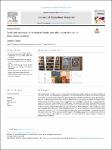Lead and mercury in historical books and their contribution to dust contamination
| dc.contributor.author | Turner, A | |
| dc.date.accessioned | 2023-11-28T13:05:32Z | |
| dc.date.available | 2023-11-28T13:05:32Z | |
| dc.date.issued | 2023-09-15 | |
| dc.identifier.issn | 0304-3894 | |
| dc.identifier.issn | 1873-3336 | |
| dc.identifier.other | 131981 | |
| dc.identifier.uri | https://pearl.plymouth.ac.uk/handle/10026.1/21733 | |
| dc.description.abstract |
Historical products are often a source of toxic substances, like heavy metals, that have since been restricted. In this study, the lead (Pb) and mercury (Hg) content of 133 books housed in two collections in southwest England (a university library and council repository), and published between 1704 and 2018, have been determined on-site by X-ray fluorescence spectrometry. Lead was detected in the front panels, text blocks and interior colour illustrations of most books, with maximum concentration of 15,100 mg kg-1, 8680 mg kg-1 and 12,800 mg kg-1, respectively. However, concentrations above 1000 mg kg-1 were generally restricted to books published between about 1850 and 1960. Mercury was detected in fewer cases, but concentrations above 5000 mg kg-1 were found in the red panels, coloured illustrations and red fore-edging of books published in the Victorian era. Mean concentrations of Pb in dusts from council repository shelves (112 mg kg-1) and library shelves (159–224 mg kg-1) and light casings (71.7 mg kg-1) were significantly higher than mean concentrations in household dusts from buildings constructed over the same period (24.8 mg kg-1). The findings suggest that historical books could be a source of Pb exposure where collections are housed or sold and could also be used to improve evaluations of historical indoor pollution. | |
| dc.format.extent | 131981-131981 | |
| dc.format.medium | Print-Electronic | |
| dc.language | en | |
| dc.publisher | Elsevier BV | |
| dc.subject | Heavy metals | |
| dc.subject | Pigments | |
| dc.subject | Printed material | |
| dc.subject | XRF | |
| dc.subject | Exposure | |
| dc.title | Lead and mercury in historical books and their contribution to dust contamination | |
| dc.type | journal-article | |
| dc.type | Article | |
| plymouth.author-url | https://www.ncbi.nlm.nih.gov/pubmed/37414706 | |
| plymouth.volume | 458 | |
| plymouth.publication-status | Published | |
| plymouth.journal | Journal of Hazardous Materials | |
| dc.identifier.doi | 10.1016/j.jhazmat.2023.131981 | |
| plymouth.organisational-group | |Plymouth | |
| plymouth.organisational-group | |Plymouth|Research Groups | |
| plymouth.organisational-group | |Plymouth|Faculty of Science and Engineering | |
| plymouth.organisational-group | |Plymouth|Faculty of Science and Engineering|School of Geography, Earth and Environmental Sciences | |
| plymouth.organisational-group | |Plymouth|Research Groups|Marine Institute | |
| plymouth.organisational-group | |Plymouth|REF 2021 Researchers by UoA | |
| plymouth.organisational-group | |Plymouth|Users by role | |
| plymouth.organisational-group | |Plymouth|Users by role|Academics | |
| plymouth.organisational-group | |Plymouth|Research Groups|BEACh | |
| plymouth.organisational-group | |Plymouth|REF 2021 Researchers by UoA|UoA07 Earth Systems and Environmental Sciences | |
| plymouth.organisational-group | |Plymouth|REF 2028 Researchers by UoA | |
| plymouth.organisational-group | |Plymouth|REF 2028 Researchers by UoA|UoA07 Earth Systems and Environmental Sciences | |
| dc.publisher.place | Netherlands | |
| dcterms.dateAccepted | 2023-06-29 | |
| dc.date.updated | 2023-11-28T13:05:32Z | |
| dc.rights.embargodate | 2023-12-9 | |
| dc.identifier.eissn | 1873-3336 | |
| dc.rights.embargoperiod | forever | |
| rioxxterms.versionofrecord | 10.1016/j.jhazmat.2023.131981 |


